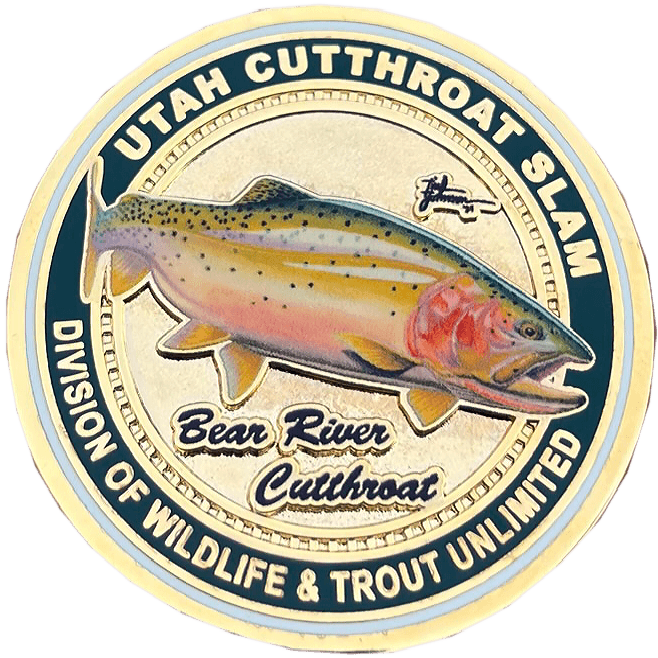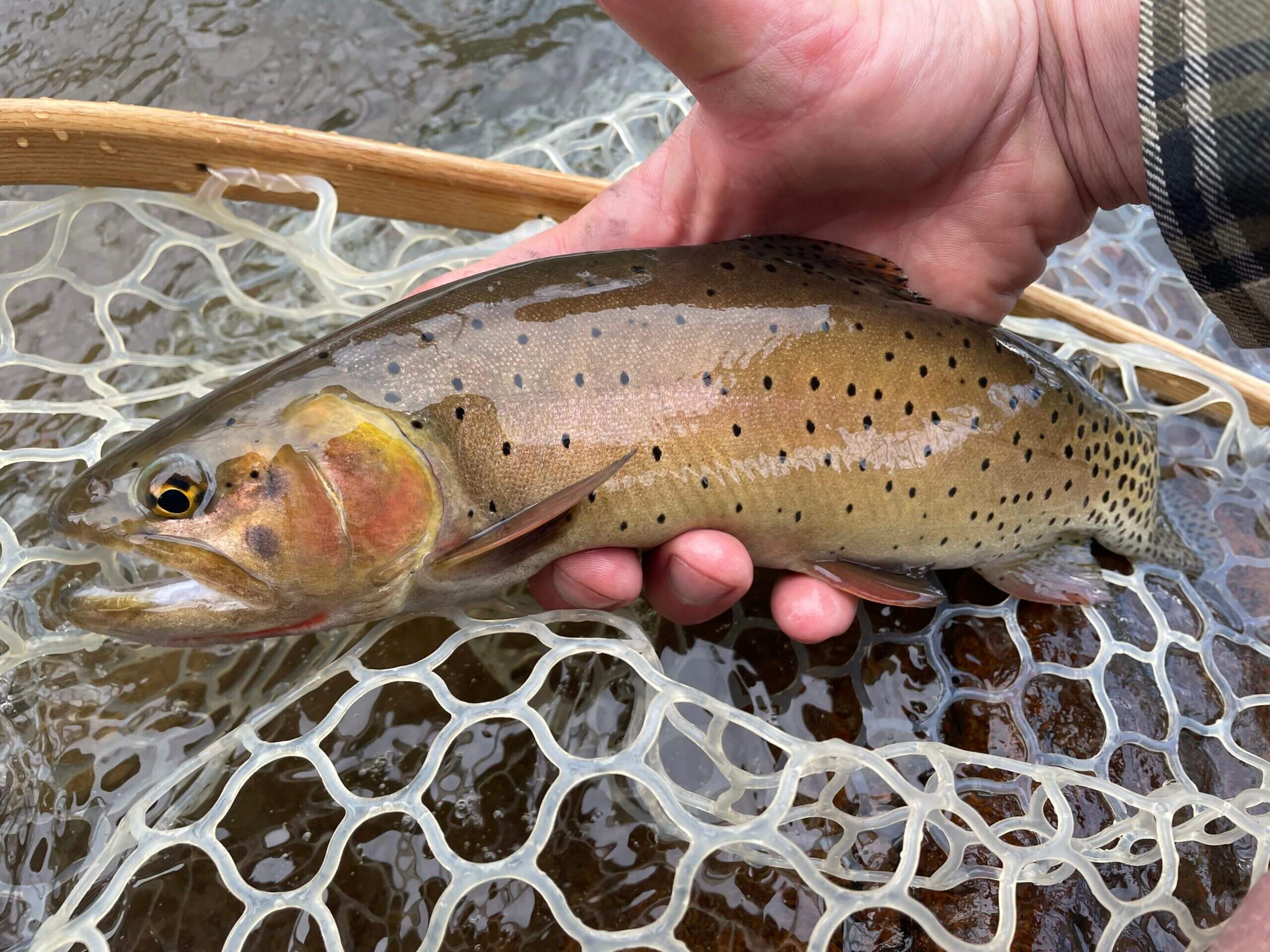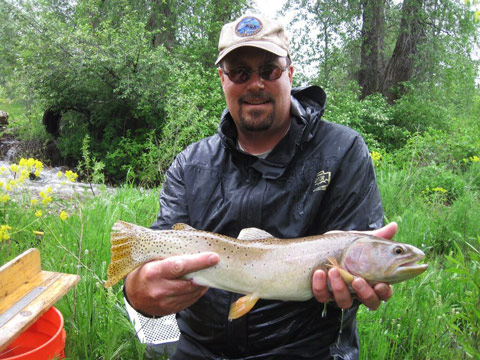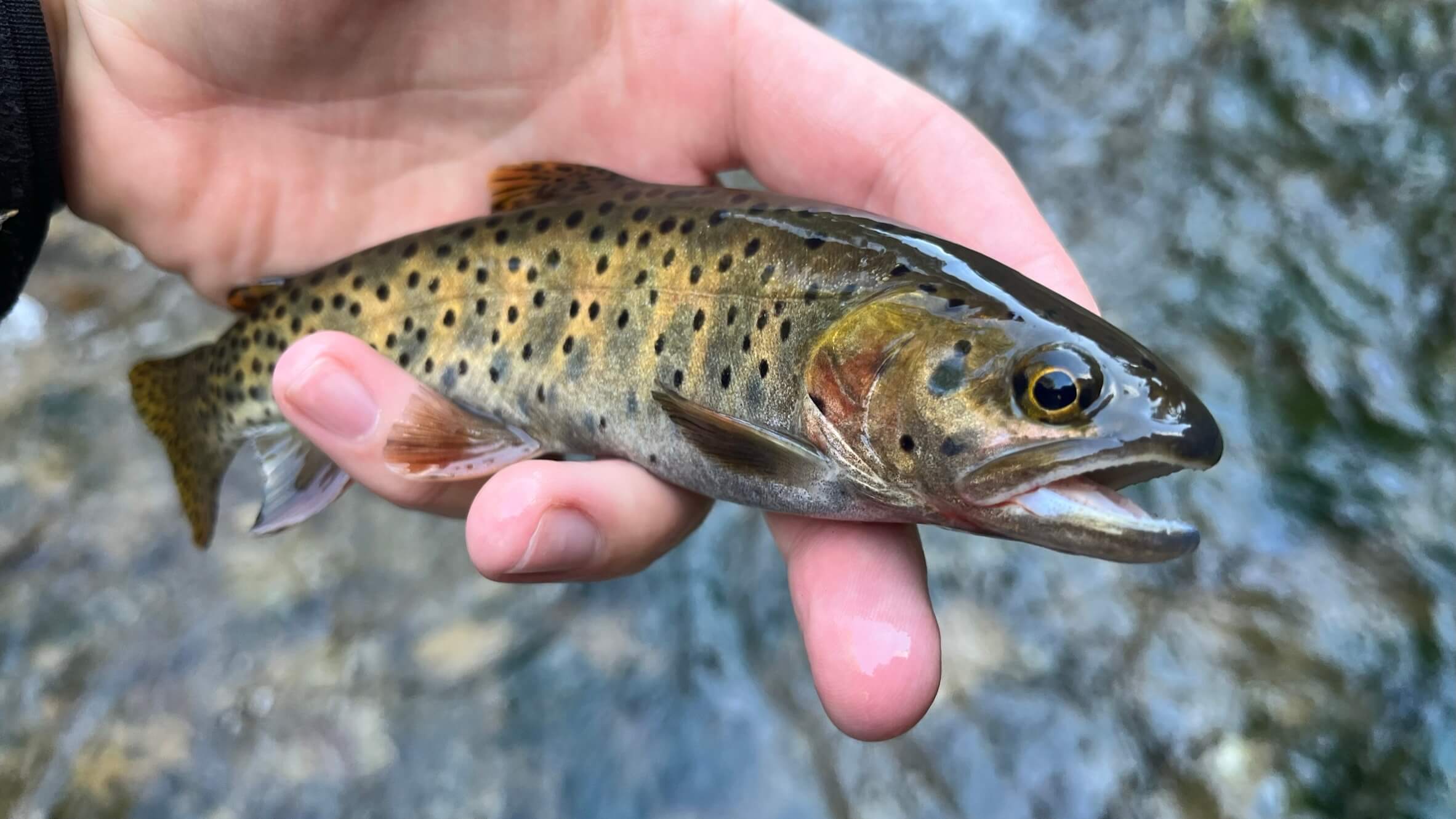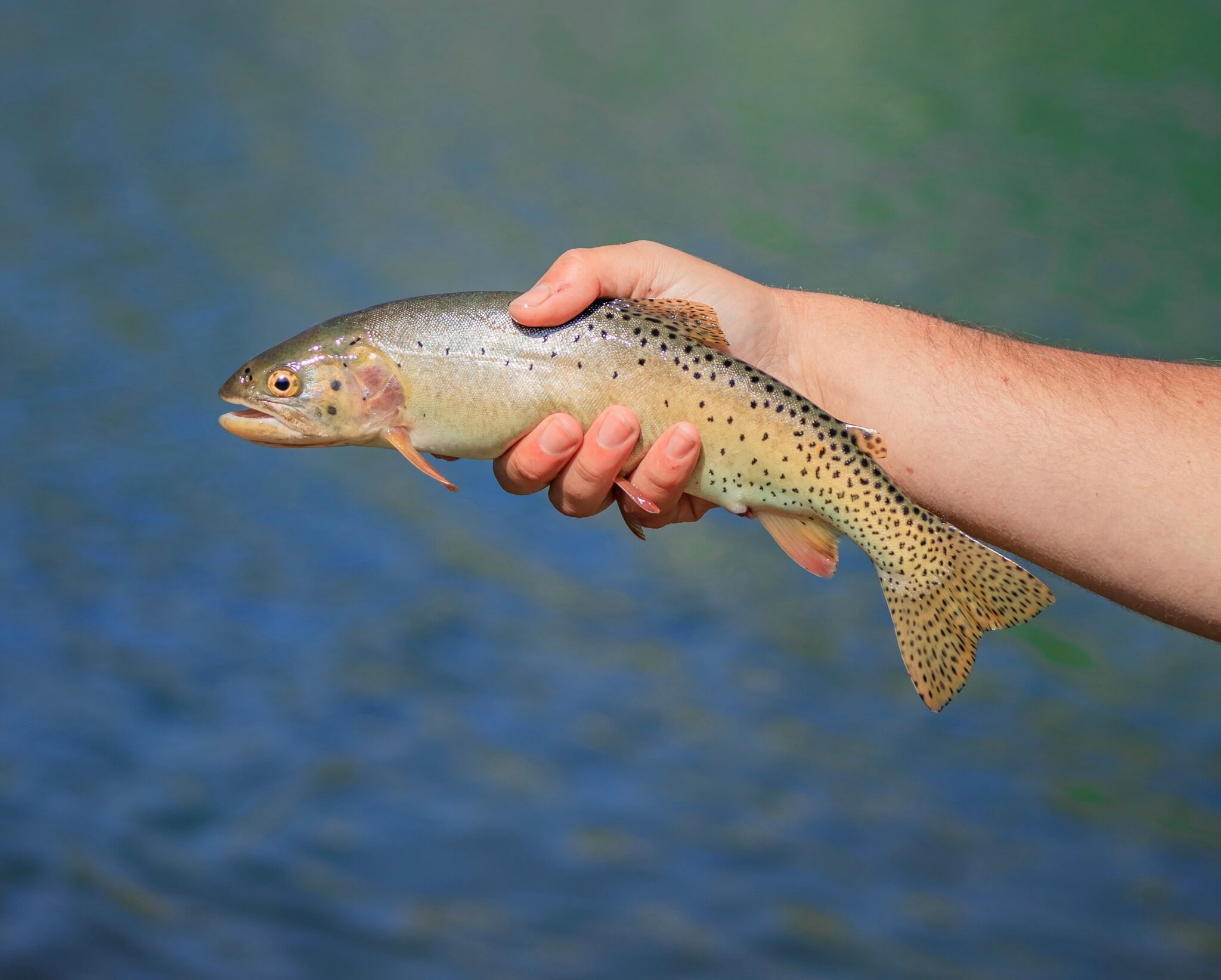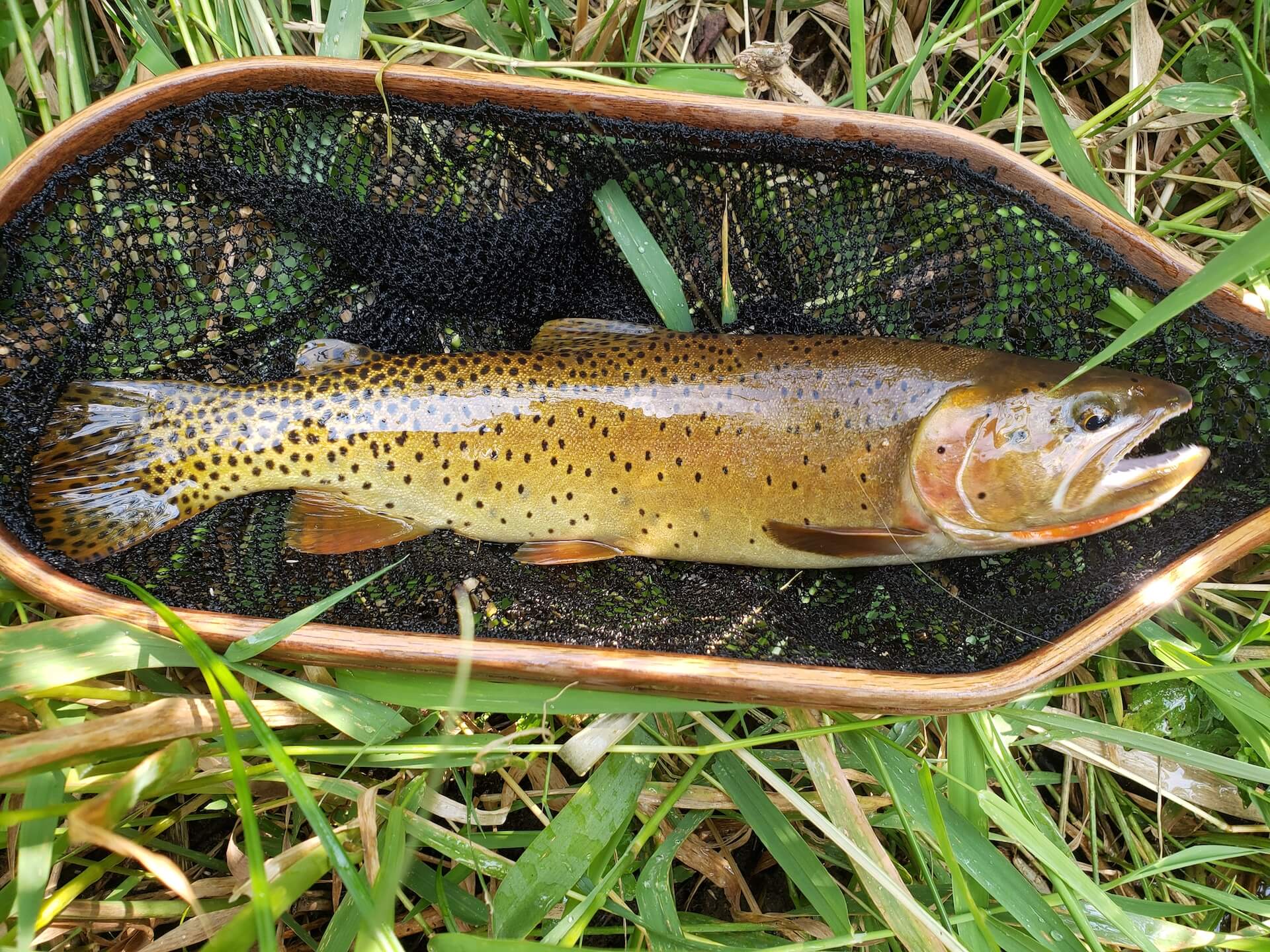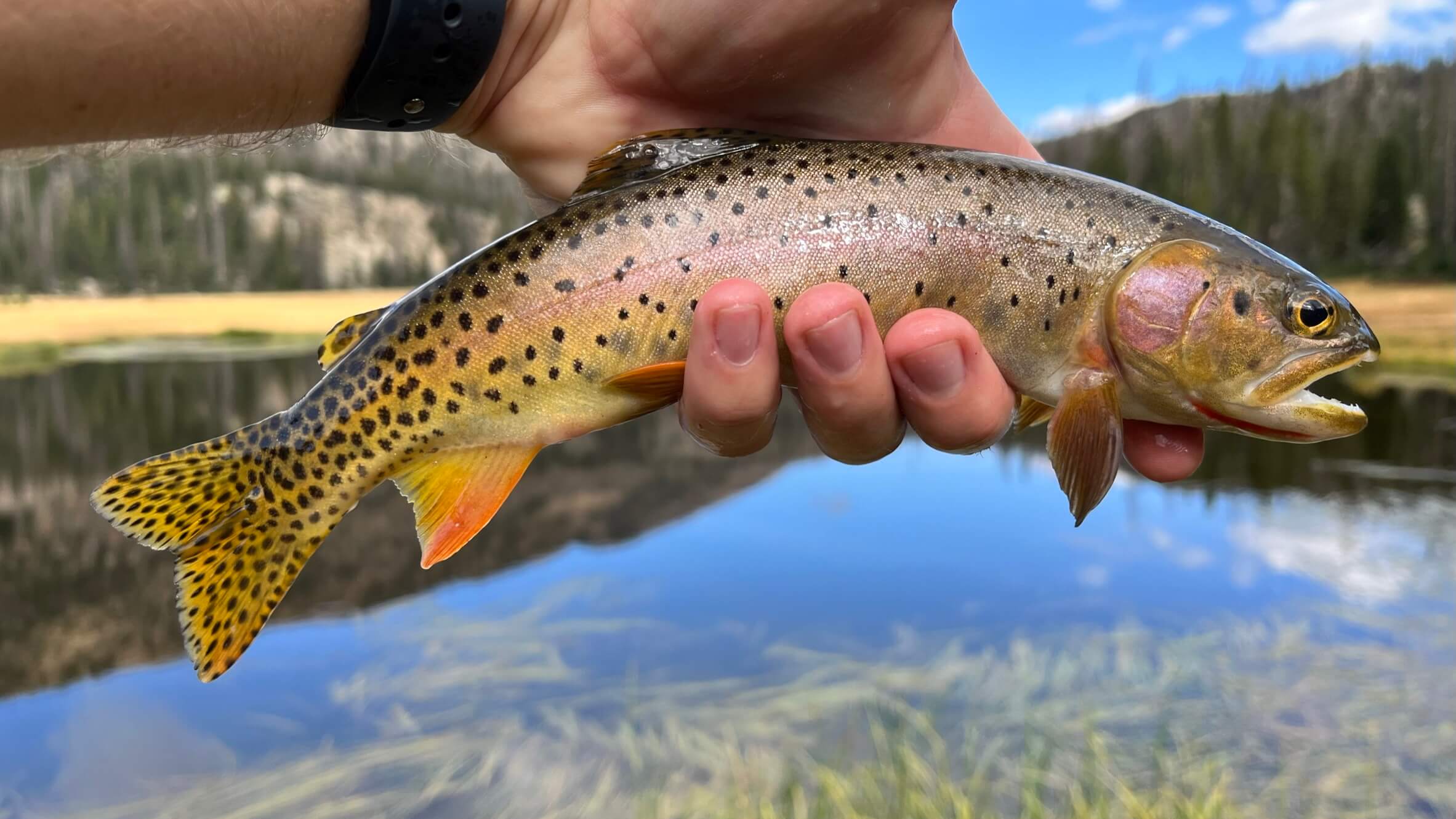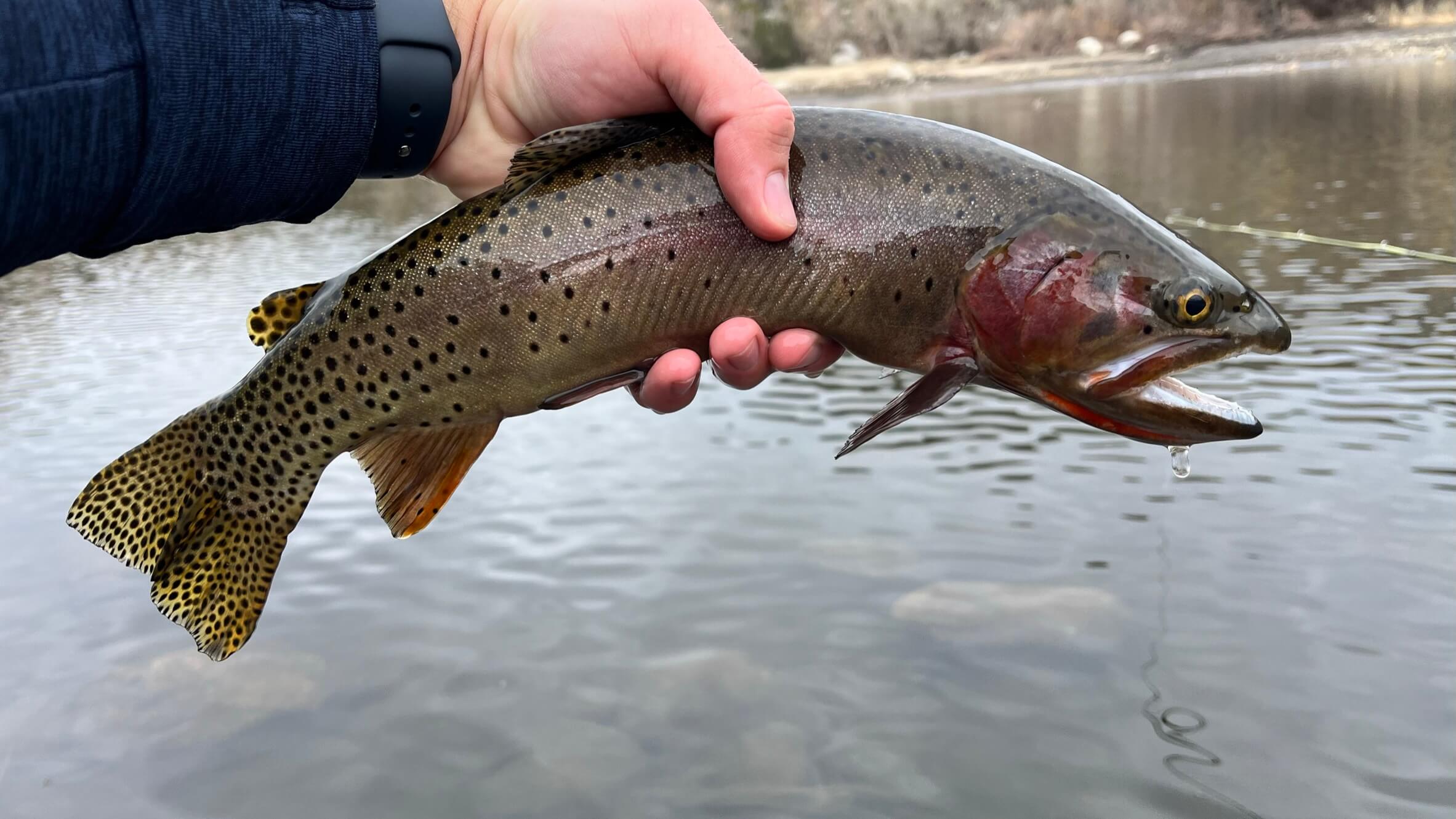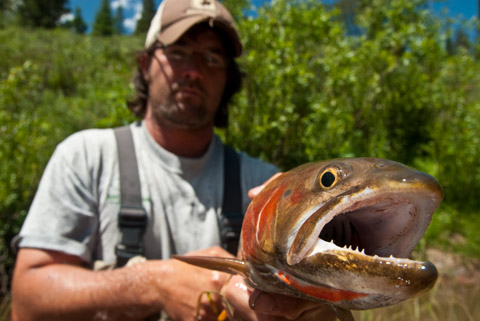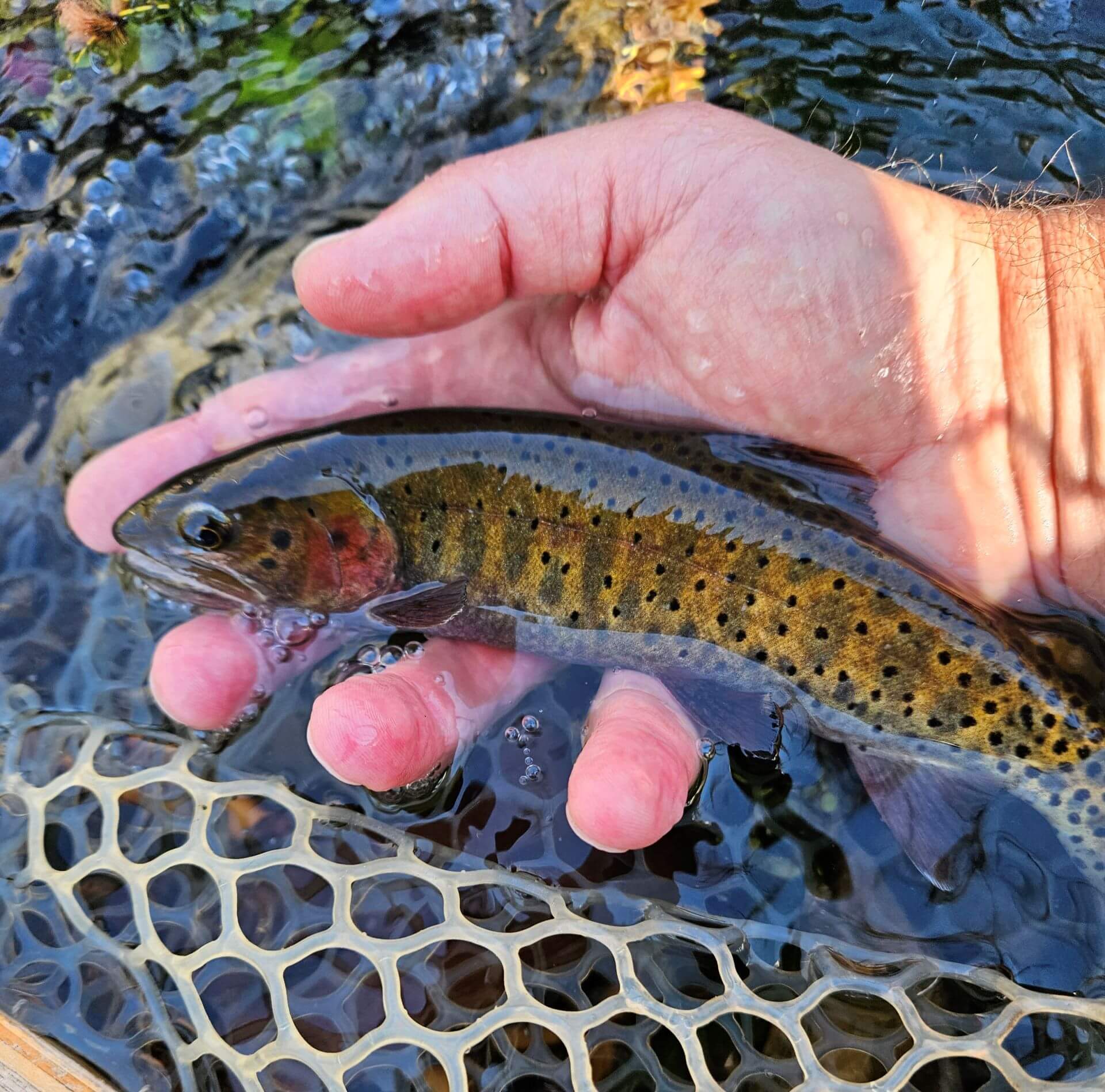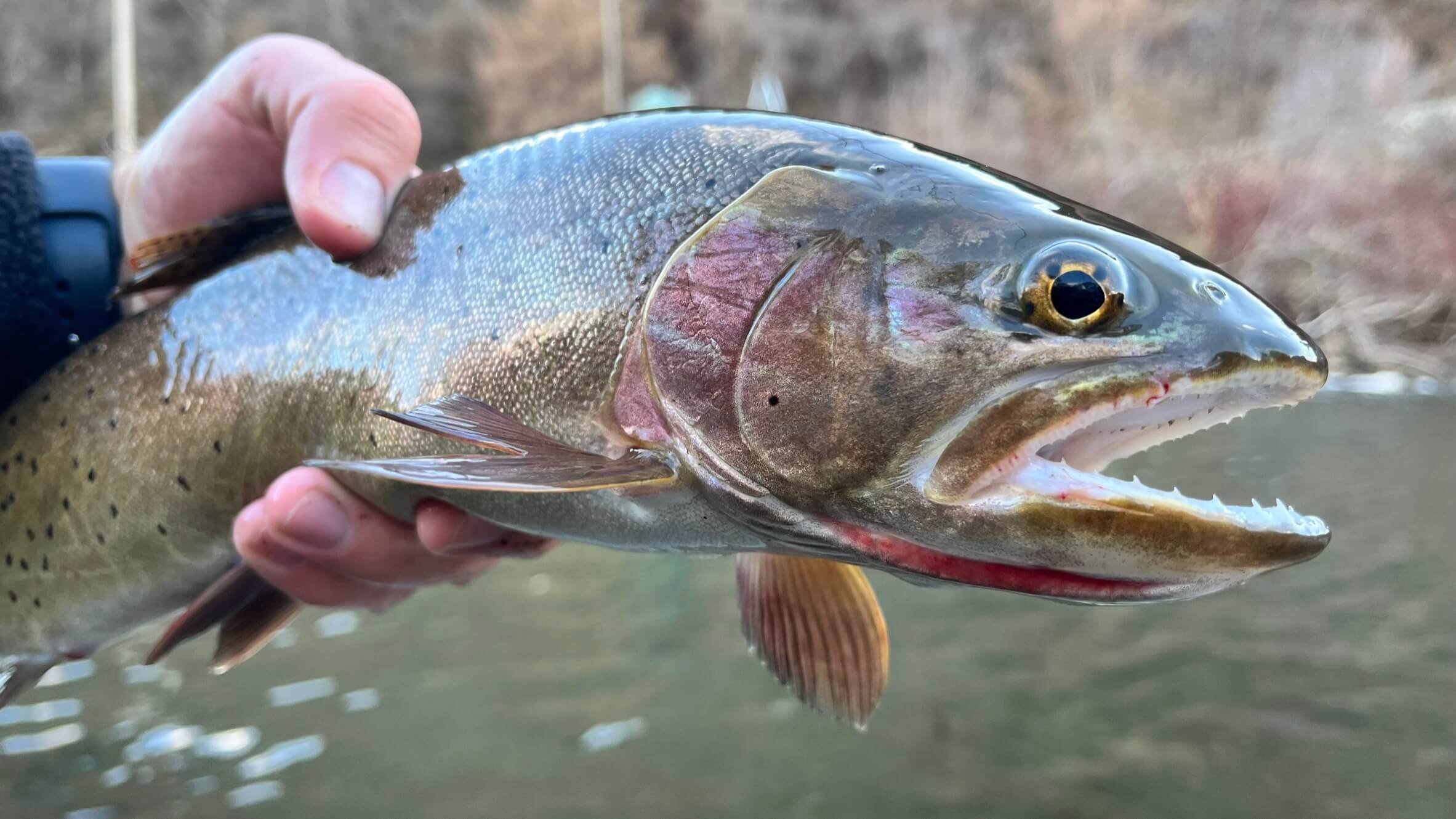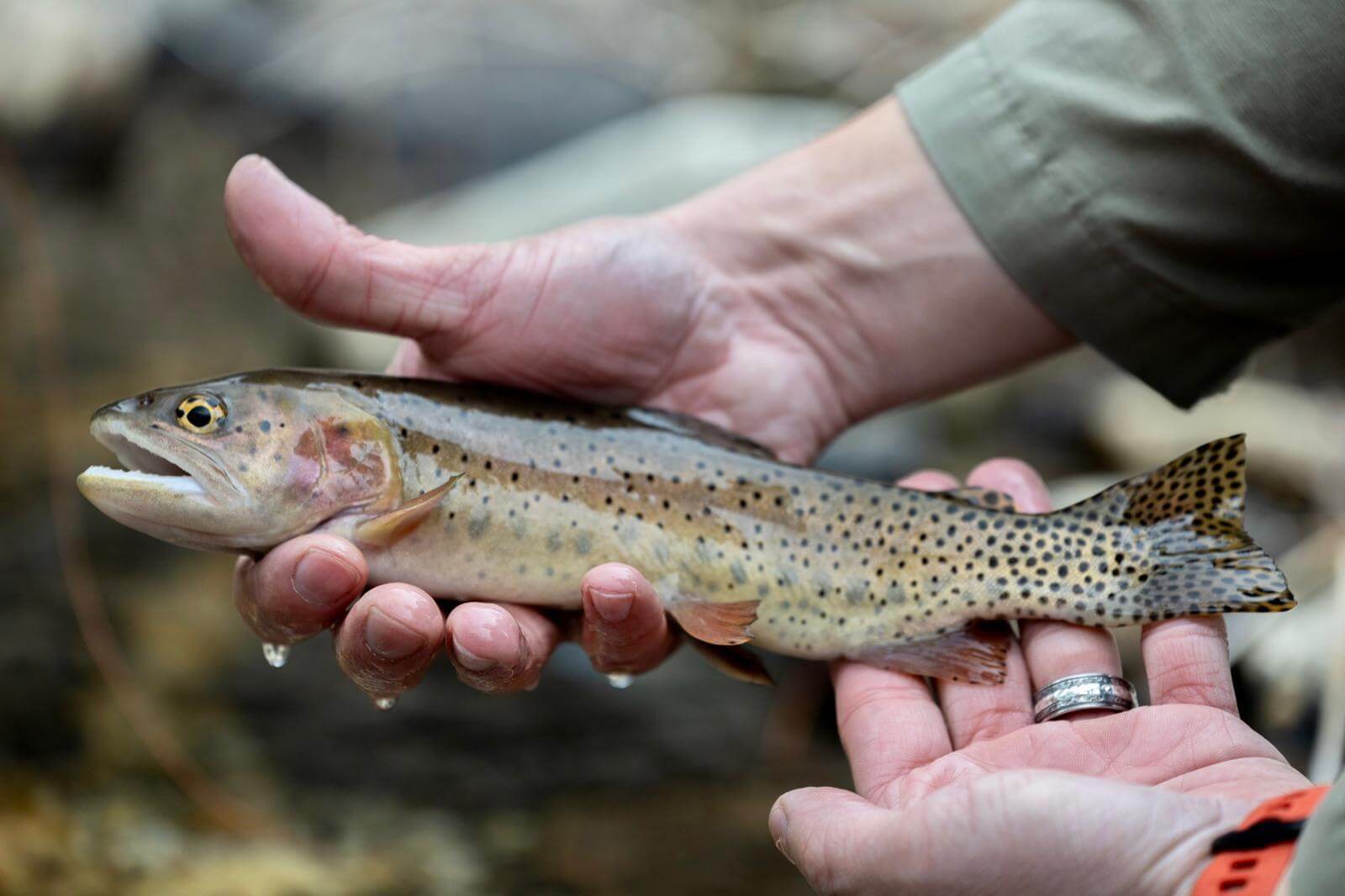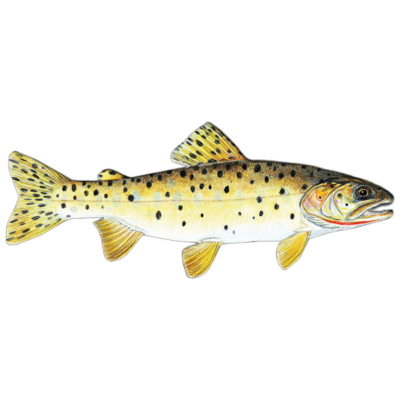Bonneville
Utah’s State Fish – Bonneville Cutthroat Trout
Oncorhynchus virginalis utah
The Bonneville Cutthroat Trout has existed in the Bonneville Basin for a millennia, with research suggesting it evolved as a separate cutthroat lineage ~1.74 million years ago. Ancient peoples in what would become Utah used Bonneville cutthroat as a primary food source. And early settlers of Utah also relied on Bonneville cutthroat to get them through the first few years. This species was once dispersed across Utah and could even be found in vast quantities in Utah Lake, where record specimens grew upwards of 36 inches and weighed around 15-16 pounds!
However, the Bonneville cutthroat was the victim of wide-spread over-fishing, competition from introduced non-native fish, and habitat degradation. In fact, by the 1970s, Bonneville cutthroat were thought to be extinct and/or genetically compromised in essentially all of their native range.
Thankfully, after an amazing story of rediscovery and restoration, our native “Bonnies” are on the rebound and offer some incredible angling opportunities in waters just minutes from major urban centers and in some much more remote places most anglers would never go.
Where to Find Bonneville Cutthroat in Utah
To zoom in, open dialogue and click on “Bonneville Cutthroat Trout”
Bonneville cutthroat trout (BCT) are native to streams that terminate in the Bonneville Basin, excluding the Bear River. While the Bear River terminates in the Bonneville Basin, these cutthroat trout have evolved on a separate path from other Bonneville cutthroat trout because of a historic stream capture of the Bear River from the Snake River to the Bonneville Basin. Any cutthroat trout caught while angling streams in the Bonneville Basin will be accepted as BCT for the Utah Native Cutthroat Slam. While the Weber River (including the Ogden River) is not in the Bear River Drainage, the Bonneville cutthroat trout in these drainages historically mixed with Bear River cutthroat trout and cutthroat trout angled in these drainages can count toward either the Bear River or Bonneville cutthroat trout catch, BUT NOT BOTH. FOR EXAMPLE, IF YOU CLAIM A BONNEVILLE CUTTHROAT TROUT CATCH FROM THE WEBER RIVER, THEN YOU NEED TO CATCH A BEAR RIVER CUTTHROAT TROUT FROM A DIFFERENT DRAINAGE AND VICE VERSA. Some headwater lakes in the Weber River and Provo River have been historically stocked with non-native cutthroat trout. If you wish to angle BCT from headwater lakes in these two drainages, check with the Northern Region UDWR Office (801-476-2740) for a list of lakes containing native BCT. The following areas/streams will provide the best opportunities to catch native Bonneville cutthroat trout in Utah:
Weber River: Special fishing regulations are present in portions of the Weber River Drainage so check the Fishing Guidebook before planning a trip.
1. Weber River from the confluence with the Ogden River upstream to Echo Dam is managed by the UDWR for native cutthroat trout (Bear River/Bonneville cutthroat trout). Land on the Weber is primarily privately owned but there are several points of public access through the Walk-In Access program.
2. Weber River and its tributaries from the town of Oakley, UT upstream to the headwaters is managed by the UDWR for native cutthroat trout (Bear River/Bonneville cutthroat trout).
3. Beaver Creek (upstream from Kamas) is managed by the UDWR for native cutthroat trout (Bear River/Bonneville cutthroat trout).
Ogden River:
South Fork of the Ogden River
Wheeler Creek. Angling conditions can be tough as Wheeler Creek is a small, brushy stream.
Wolf Creek. Angling conditions can be tough as Wolf Creek is a small, brushy stream.
Sevier River:
Salina Creek: the reach upstream from Interstate 70 will have more pure fish as rainbow trout occur downstream.
Manning Creek (Monroe Mountains)
Clear Creek and tributaries (65 total stream miles) now contain BCT after extensive restoration efforts.
Mammoth Creek upstream of Mammoth Spring
East Fork Sevier River in Black Canyon, upper Sevier River, and Asay Creek near Hatch are stocked annually with BCT.
Southern Utah Lakes – BCT are stocked annually in Manning Meadow Reservoir, Barney Lake, Pine Lake, Yankee Meadow Reservoir, Upper Enterprise Reservoir, and all three Kent’s Lakes on Beaver Mountain.
Central Region Waters (CRO) where BCT fishing opportunities exist. Below are the waters where Bonneville cutthroat trout present are considered to be genetically pure:
1) American Fork River Drainage
a) Silver Lake Flat Reservoir and Silver Lake are home to BCT and anglers are catching them in the lake, reservoir and Silver Creek both above and below the reservoir.
b) Mary Ellen Gulch, a tributary to the North Fork of American Fork River approximately 4 miles upstream from Tibble Fork Reservoir has a small population of pure BCT for anglers to enjoy.
c) North Fork of American Fork Canyon River below Tibble Fork and above Tibble Fork up to Dutchman Flat and Mineral Basin.
2) Spanish Fork River Drainage
a) Headwaters of Diamond Fork River a tributary to the Spanish Fork River is managed by the UDWR for BCT. The Tributaries include Upper Diamond Fork River, Shingle Mill Creek, Chase and Halls Fork Creek. Each of these creeks were restored for native BCT in 2006 and a fish migration barrier was constructed near Three Forks to prevent other non-native trout species from mixing and competing with the BCT in the 21 miles of these headwaters streams. Diamond Fork itself also has also been stocked with BCT since the 2018 fires.
b) Sixth Water Creek, a tributary to Diamond Fork is also home to catchable BCT. A favorite place to catch these BCT is above and below the Ray’s Valley Bridge area.
c) Right Fork of Clear Creek and Starvation Creek, tributaries to Soldier Creek in the upper portion of Spanish Fork Canyon are managed by UDWR for BCT. Angling conditions can be tough as Clear Creek is a small, brushy stream that is accessed along the northern end of Skyline Drive (USFS Road 150) from HWY 6 and Starvation Creek often runs off-colored.
d) Nebo Creek, Holman Creek and Bennie Creek. Fires in 2018 removed all fish in this drainage. BCT were re-introduced in 2019 and are doing very well.
e) Upper reaches of LF and RF of Hobble Creek and Wadsworth Creek have recently been stocked with BCT. Most fish present in these creeks are brown trout but an occasional BCT can be caught as well.
f) Salt Creek up the Nebo Loop Road in Nephi Canyon now has a small population of BCT. Majority of fish here are brown trout but some BCT are present.
3) Provo River Drainage
a) Upper Provo River is managed by DWR for BCT. The Upper South Fork and its tributaries including Buck Hollow and Benches Creek are the best locations to target BCT in the Upper Provo River area. These streams are small with Benches Creek being very tight and brushy to fish.
b) For viewing purposes only, Cascade Springs is now home to a recently reintroduced population of genetically pure BCT (fall 2017). This is a great place to take the kids to see native BCT in the clear spring pools of Cascade Springs.
4) Jordan River Drainage
a) Mill Creek in Millcreek Canyon just East of Salt Lake City near 3300 south and Wasatch Blvd is home to a completely restored native fish community and includes native BCT from the mouth of the canyon to the headwaters. This is a great place close to home to catch the native BCT.
b) Parley’s Canyon Creek is managed by UDWR for BCT. It runs adjacent to Interstate 80 and is bisected in several locations by the interstate.
c) Mountain Dell Creek a tributary to Little Dell Reservoir is managed by UDWR for BCT. It is also home to brook trout. Catch and release only for BCT and artificial flies and lures only regulations apply.
d) Lambs Canyon Creek is a small very brushy stream where BCT were restored by UDWR and is now managed for BCT. Hard to fish in most stretches due to the brush covering most of the stream.
e) Little Dell Reservoir is managed by DWR as a wild brood population of BCT and is used to supplement all the other BCT populations along the Wasatch Front for both conservation and sportfish purposes. Eggs and milt from adult BCT running up Mountain Dell Creek are collected to be reared for supplemental stocking. Catch and release only of BCT is allowed in this 250-acre reservoir. Brook trout can also be caught and UDWR encourages anglers to harvest a limit of brook trout. Only artificial flies and lures are allowed and no motors or swimming are allowed on the reservoir, float tubes and canoes or kayaks are popular and allowed.
f) Mountain Dell Reservoir was recently drained for dam repairs and it is closed to fishing and trespass to protect water treatment needs. It is home to BCT and UDWR uses this population of BCT as a brood source to supplement the other BCT populations along the Wasatch Front for both conservation and sportfish purposes. Like Little Dell, eggs and milt from adult BCT running up Parley’s Creek are collected to be reared in the hatchery for supplemental stocking.
g) Lower Bells Reservoir is a short hike from Wasatch Blvd area at 3450 E. Little Cottonwood Rd and home to a nice BCT population.
h) Big Cottonwood Canyon Creek in the Cardiff Flat area has been stocked with BCT. Majority of the fish present here are brown trout but one may catch some BCT on occasion.
5) Wasatch Front High Mountain Lakes
a) Several of the High Mountain Lake along the Wasatch Front above the Salt Lake Valley are managed by DWR for BCT and are stocked frequently with native BCT. These lakes include; White Pine Lake, Red Pine Lake and Upper Red Pine Lake all in Little Cottonwood Canyon. These lakes require a 2-3 hour hike on good USFS trails to reach and fish. Upper Bells Reservoir just south of Little Cottonwood Canyon is also home to BCT and requires a 3-hour hike to fish. The streams leaving these reservoirs are also home to native BCT. Twin Lake in Big Cottonwood Canyon is managed for BCT and is just a 30-minute hike from the west side of the Brighton Ski Resort parking lot.
6) Deep Creek Mountain Streams
a) Beginning at the southern end of the Deep Creek Range and moving north along the eastern slope the streams are; Trout Creek, Birch and North Fork of Birch Creek, Granite Creek, Red Cedar Creek, Tom’s Creek, Indian Farms Creek and Basin Creek. Each of these streams can be accessed from the valley floor by dirt road and most have limited trails anglers can follow for access to the stream to fish. Tom’s and Indian Farms Creeks have roads that can provide some access to upper reaches of these two streams for additional fishing opportunities. All of these streams are managed by UDWR Central Region Office for and contain genetically pure populations of BCT.
Each of these streams terminate at the valley floor, they are small streams that are very tight and brushy with multiple plunge pools and vertical fish migration barriers throughout the length of the streams. These are very remote streams and receive very little pressure and can be a great place to be alone and have a great fishing experience for Utah’s native BCT.
7) Other Waters
FYI, there are many other waters within the CRO that have cutthroat trout but in many of these other waters the cutthroat would be considered hybridized or not pure BCT so they have not been included in this list. However, for the purposes of the Cutthroat Slam Program these other waters would also qualify for catching BCT within their native range. For more information on these additional angling opportunities or any of those listed above, call the Central Region Office at 801-491-5678.
With any of these streams or fishing in general we would encourage anglers to check the Fishing Guidebook for specific rules and regulations. A few of the waters listed may be catch and release only or require use of artificial flies and lures.
Bonneville Cutthroat Facts
Designated as the official state fish of Utah in 1997, replacing the non-native rainbow trout
Once existed in great numbers in Utah Lake and reported to reach sizes of 15-16 lbs. and 36 inches!
One of the principle sources of food for native tribes and early Utah pioneers
First rediscovered in 1974, extensive restoration efforts have restored Bonnies into 41% of their original range
Ready to Get Started?
The Utah Cutthroat Slam is a challenge and an adventure. Visit incredible waters to see what trout fishing in Utah was like way back then. Help Trout Unlimited and the Utah Division of Wildlife Resources restore and protect Utah’s incredible trout legacy and have fun along the way.
